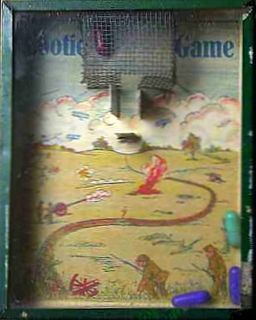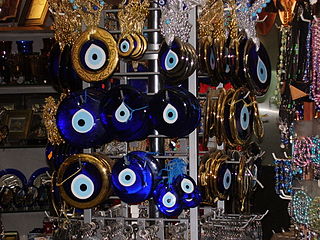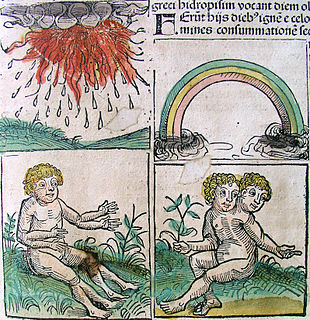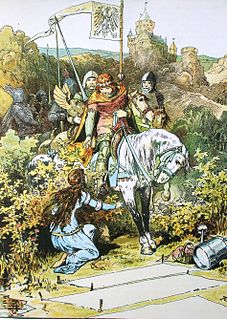 W
WThe Ace of Spades is traditionally the highest and most valued card in the deck of playing cards in English-speaking countries. The actual value of the card varies from game to game.
 W
WBad Luck Blackie is a 1949 American animated comedy short film produced by Metro-Goldwyn-Mayer.
 W
WConcealed shoes hidden in the fabric of a building have been discovered in many European countries, as well as in other parts of the world, since at least the early modern period. Independent researcher Brian Hoggard has observed that the locations in which these shoes are typically found – in chimneys, under floors, above ceilings, around doors and windows, in the roof – suggest that some may have been concealed as magical charms to protect the occupants of the building against evil influences such as demons, ghosts and witches. Others may have been intended to bestow fertility on a female member of the household, or been an offering to a household deity.
 W
WCooties is a fictitious childhood disease, commonly represented as childlore. It is used in the United States, Canada, Australia, New Zealand, and the Philippines as a rejection term and an infection tag game. It is similar to the British 'dreaded lurgi', and to terms used in the Nordic countries, in Italy, India and Iraq. A child is said to "catch" cooties through close contact with an "infected" person or from an opposite-sex child of a similar age.
 W
WDavy Jones' Locker is a metaphor for the bottom of the sea: the state of death among drowned sailors and shipwrecks. It is used as a euphemism for drowning or shipwrecks in which the sailors' and ships' remains are consigned to the depths of the ocean.
 W
WThe makeup of poker's dead man's hand has varied through the years. Currently, it is described as a two-pair poker hand consisting of the black aces and black eights. The pair of aces and eights, along with an unknown hole card, were reportedly held by Old West folk hero, lawman and gunfighter, Wild Bill Hickok when he was murdered while playing a game. No contemporaneous source, however, records the exact cards he held when killed. Author Frank Wilstach's 1926 book, Wild Bill Hickok: The Prince of Pistoleers, led to the popular modern held conception of the poker hand's contents.
 W
WDuring the Middle Ages in Europe, Egyptian days were certain days of the year held to be unlucky. The Egyptian days were:January 1, 25 February 4, 26 March 1, 28 April 10, 20 May 3, 25 June 10, 16 July 13, 22 August 1,30 September 3, 21 October 3, 22 November 5, 28 December 7, 22
 W
WThe evil eye is a superstitious belief in curse, believed to be cast by a malevolent glare, usually given to a person when one is unaware. It dates back at least to Greek classical antiquity, 6th century BC where it appeared on Chalcidian drinking vessels, known as 'eye-cups', as a type of apotropaic magic. Many cultures believe that receiving the evil eye will cause misfortune or injury, while others believe it to be a kind of supernatural force that casts or reflects a malevolent gaze back-upon those who wish harm upon others. Older iterations of the symbol were often made of ceramic or clay; however, following the production of glass beads in the Mediterranean region in approximately 1500 BC, evil eye beads were popularised with the Phoenicians, Persians, Greeks, Romans and Ottomans. Blue was likely used as it was relatively easy to create; however, modern evil eyes can be a range of colors.
 W
WFeng shui, also known as Chinese geomancy, is a pseudoscientific traditional practice originating from ancient China, which claims to use energy forces to harmonize individuals with their surrounding environment. The term 'feng shui' literally translated as "wind-water" in English, is taken from a passage of the now-lost Book of Burial recorded in Guo Pu's commentary.
 W
WThe Flying Dutchman is a legendary ghost ship which was said to never be able to make port, doomed to sail the oceans forever. The myth is likely to have originated from the 17th-century Golden Age of the Dutch East India Company (VOC) and Dutch maritime power. The oldest extant version of the legend has been dated to the late 18th century. According to the legend, if hailed by another ship, the crew of the Flying Dutchman was said to try to send messages to land, or to people long dead. Purported sightings in the 19th and 20th centuries claimed that the ship glowed with a ghostly light. In ocean lore, the sight of this phantom ship is a portent of doom.
 W
WGroundhog Day is a popular North American tradition observed in the United States and Canada on February 2. It derives from the Pennsylvania Dutch superstition that if a groundhog emerging from its burrow on this day sees its shadow due to clear weather, it will retreat to its den and winter will persist for six more weeks; if it does not see its shadow because of cloudiness, spring will arrive early.
 W
WA Klabautermann is a water kobold that assists sailors and fishermen on the Baltic and North Sea in their duties. It is a merry and diligent creature, with an expert understanding of most watercraft, and an irrepressible musical talent. It is believed to rescue sailors washed overboard. The name comes from the Low German verb klabastern meaning "rumble" or "make a noise". An etymology deriving the name from the verb kalfatern has also been suggested.
 W
WKnocking on wood, also touching wood, is an apotropaic tradition of literally touching, tapping, or knocking on wood, or merely stating that one is doing or intending to do so, in order to avoid "tempting fate" after making a favorable prediction or boast, or a declaration concerning one's own death or another unfavorable situation.
 W
WLiteromancy, from the Latin litero, "letter", mancy, "divination", is a form of fortune-telling based on written words, or, in the case of Chinese, characters. A fortune-teller of this type is known as a literomancer.
 W
WA lock of hair is a piece or pieces of hair that has been cut from, or remains singly on, a human head, most commonly bunched or tied together in some way. A standard dictionary definition defines a lock as a tress, curl, or ringlet of hair.
 W
WA Lovelock was popular amongst European "men of fashion" from the end of the 16th century until well into the 17th century. The lovelock was a long lock of hair, often plaited (braided) and made to rest over the left shoulder to show devotion to a loved one.
 W
WThe miasma theory is an obsolete medical theory that held that diseases—such as cholera, chlamydia, or the Black Death—were caused by a miasma, a noxious form of "bad air", also known as night air. The theory held that epidemics were caused by miasma, emanating from rotting organic matter. Though miasma theory is typically associated with the spread of contagious diseases, some academics in the early nineteenth century suggested that the theory extended to other conditions as well, e.g. one could become obese by inhaling the odor of food.
 W
WNeed-fire, or Wild-fire is a term used in folklore to denote a superstition which survived in the Scottish Highlands until a recent date.
 W
WAn omen is a phenomenon that is believed to foretell the future, often signifying the advent of change. It was commonly believed in ancient times, and still believed by some today, that omens bring divine messages from the gods.
 W
WA superstition in Western cultures holds that spilling salt is an evil omen. However, salt has had a variety of meanings in religions around the world.
 W
WSriramachakra is a mystic diagram or a yantra given in Tamil almanacs as an instrument of astrology for predicting one's future. The geometrical diagram consists of a square divided into smaller squares by equal numbers of lines parallel to the sides of the square. Certain integers in well defined patterns are written in the various smaller squares. In some almanacs, for example, in the Panchangam published by the Sringeri Sharada Peetham or the Pnachangam published by Srirangam Temple, the diagram takes the form of a magic square of order 4 with certain special properties. This magic square belongs to a certain class of magic squares called strongly magic squares which has been so named and studied by T V Padmakumar, an amateur mathematician from Thiruvananthapuram, Kerala. In some almanacs, for example, in the Pambu Panchangam, the diagram consists of an arrangement of 36 small squares in 6 rows and 6 columns in which the digits 1, 2, ..., 9 are written in that order from left to right starting from the top-left corner, repeating the digits in the same direction once the digit 9 is reached.
 W
WStatue rubbing is the act of touching a part of a public statue. Popular among tourists, it is a form of superstition that is believed to bring good luck, ensure a return to the city, improve love life or make a wish come true.
 W
WThe thirteenth floor is a designation of a level of a multi-level building that is often omitted in countries where the number 13 is considered unlucky. Omitting the 13th floor may take a variety of forms; the most common include denoting what would otherwise be considered the thirteenth floor as level 14, giving the thirteenth floor an alternate designation such as "12A" or "M", or closing the 13th floor to public occupancy or access.
 W
W"The Three Sisters" or Green Meadow is an Italian literary fairy tale written by Giambattista Basile in his 1634 work, the Pentamerone.
 W
WA threshold is the sill of a door. Some cultures attach special symbolism to a threshold. It is called a door saddle in New England.
 W
WA wedding is a celebratory ceremony where two people are brought together in matrimony. Wedding traditions and customs differ across cultures, countries, religions, and societies in terms of how a marriage is celebrated, but are strongly symbolic, and often have roots in superstitions for what makes a lucky or unlucky marriage. Superstition is often linked to practices involving luck, fate or prophecy, and while many weddings are now more focused on celebratory traditions, many are still practiced, and numerous well-known wedding traditions have roots in superstitions from previous ages. A common example of a superstition involves no one seeing the bride in her wedding dress until the ceremony.
 W
WA wish is a hope or desire for something. In fiction, wishes can be used as plot devices. In folklore, opportunities for "making a wish" or for wishes to "come true" or "be granted" are themes that are sometimes used.
 W
WA wishing well is a term from European folklore to describe wells where it was thought that any spoken wish would be granted. The idea that a wish would be granted came from the notion that water housed deities or had been placed there as a gift from the gods. This practice is thought to have arisen because water is a source of life, and was often a scarce commodity.
 W
WIn folklore, the witching hour or devil's hour is a time of night that is associated with supernatural events, whereby witches, demons and ghosts are thought to appear and be at their most powerful. Definitions vary, and include the hour immediately after midnight, and the time between 3:00 am and 4:00 am.